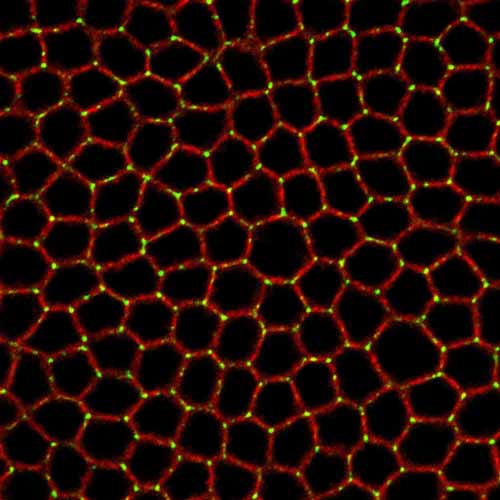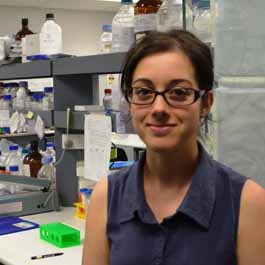Teresa Bonello Alumna Page
Background & Contact Information
Currently: Research Fellow, Barry Thompson Lab, EMBL-Australia and Australian National University
Postdoctoral Fellow, Peifer Lab (2014 – 2019)
Education: PhD in Cell Biology, 2013., University of New South Wales, (Advisor Peter Gunning)
Fellowships & Awards: Sir Keith Murdoch Fellowship from the American Australian Association (2014)
Email: Teresa.Bonello@anu.edu.au

Research Information
Cells change shape or move together as a sheet in a coordinated fashion to build tissue and maintain homeostasis. The loss of cell linkage within this sheet is an initiating event in metastasis – the propagation of cancer cells to distant sites in the body. I seek to define the structural machinery linking cells together and the network of proteins regulating tissue assembly and maintenance. Understanding their normal mechanism of action, will ultimately allow us to understand how these points of anchorage are altered in human tumours.
Using fly embryogenesis as a model, my research focuses on understanding how the protein network controlling cell-cell junctions is choreographed to achieve the correct functional outcome. The fly afadin homologue,Canoe, coordinates a suite of proteins involved in regulating apical junctions and maintaining cell polarity, both essential for embryogenesis. Drosophilacellularization provides a superb model for polarity establishment.Work from our lab and others identified Bazooka/Par3 as a key polarity cue required for adherens junction establishment during cellularization, and found that bothCanoe/Afadin, which links adherens junctions to the underlying actin cytoskeleton, and its regulator Rap1 actupstream of Bazooka. We recently found that Rap1 acts at multiple levels during the polarity establishment phase, facilitatingretention of Canoe at the membrane, andalso directing correct apical positioning and organization of Canoe into supermolecular assemblies at tricellular junctions. We also found that the Rap1 GEF Dizzy directs a subset of these events. Our data reveal that the regulation of apical-basal polarity establishment by Rap1 requires a diverse set of inputs that specify unique aspects of Canoe’s behaviour on the polarizing membrane.
In the current model, Rap1/Canoe, Bazooka and adherens junctions initiate polarity, and subsequently other protein complexes are recruited to elaborate on the polarity program. We recently found that this linear hierarchyis significantly oversimplified. Instead, proteins of the basolateral Scribble polarity module are required at the onset of polarity establishment to spatially restrict Canoe to apical ends of polarizing cells. Strikingly, mislocalized Canoe puncta continue to colocalize with adherens junction proteins. This suggests that Scribble is not required for molecular assembly of adherens junctions but is critical for both apical positioning and the supermolecular assembly of smaller cadherin-catenin complexes into mature spot junctions. Intriguingly, overexpressing Canoe in a scribbleRNAi background altered architecture of the mislocalized Canoe puncta, with assembly of more contiguous structures that may represent enhanced clustering. These data form part of a larger scale effort in our lab to define the full network of proteinsand mechanisms by which individual cadherin-catenin complexes are assembled to form apical adherens junctions, which then serve to direct elaboration of apical-basal polarity.
- Bonello, T.T., Choi, W., and Peifer, M. (2019). Scribble and Discs-large direct initial assembly and positioning of adherens junctions during establishment of apical-basal polarity. Development, in press.
- Bonello, T.T. and Peifer, M. (2019). Scribble: A master scaffold in polarity, adhesion, synaptogenesis and proliferation. Journal of Cell Biology 218, 742-756.
- Bonello, T.T., Perez-Vale, K.Z., Sumigray, K.D., and Peifer, M. (2018) Rap1 acts via multiple mechanisms to position Canoe/Afadin and adherens junctions and mediate apical-basal polarity establishment. Development .
- Schaefer, K.N., Bonello, T.T., Zhang, S., Williams, C.E., Roberts, D.M., McKay, D.J, and Peifer, M. (2018). Supramolecular assembly of the beta-catenin destruction complex and the effect of Wnt signaling on its localization, molecular size, and activity in vivo. PLoS Genetics doi.org/10.1371/journal.pgen.1007339.
- Janco M, Bonello TT, Byun A, Coster AC, Lebhar H, Dedova I, Gunning PW, Böcking T. (2016) The impact of tropomyosins on actin filament assembly is isoform specific. Bioarchitecture. 6, 61-75
- Bonello TT, Janco M, Hook J, Byun A, Appaduray M, Dedova I, Hitchcock-DeGregori S, Hardeman EC, Stehn JR, Böcking T, Gunning PW. (2016). A small molecule inhibitor of tropomyosin dissociates actin binding from tropomyosin-directed regulation of actin dynamics. Sci Rep. 6:19816. doi: 10.1038/srep19816
- Prunotto M, Bruschi M, Gunning P, Gabbiani G, Weibel F, Ghiggeri GM, Petretto A, Scaloni A, Bonello T, Schevzov G, Alieva I, Bochaton-Piallat ML, Candiano G, Dugina V, Chaponnier C. (2015) Stable incorporation of α-smooth muscle actin into stress fibers is dependent on specific tropomyosin isoforms. Cytoskeleton 72, 257-67
- Stehn JR, Haass NK, Bonello T, Desouza M, Kottyan G, Treutlein H, Zeng J, Nascimento PR, Sequeira VB, Butler TL, Allanson M, Fath T, Hill TA, McCluskey A, Schevzov G, Palmer SJ, Hardeman EC, Winlaw D, Reeve VE, Dixon I, Weninger W, Cripe TP, Gunning PW. (2013). A novel class of anticancer compounds targets the actin cytoskeleton in tumor cells.Cancer Research 73, 5169-82
- Bonello TT, Stehn JR, Gunning PW. (2009). New approaches to targeting the actin cytoskeleton for chemotherapy. Future Med Chem. 1, 1311-31.



